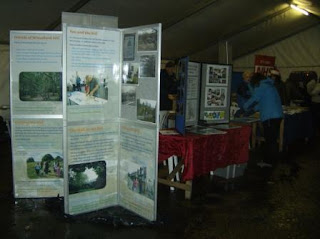 The snow is melting and normal life has resumed. The Firth Park Christmas Winter Fest went ahead and although it was a chilly drippy affair there was plenty of good cheer in the big tent. The children from Hatfield Primary School paraded their lanterns and the Community Choir sang valiantly.
The snow is melting and normal life has resumed. The Firth Park Christmas Winter Fest went ahead and although it was a chilly drippy affair there was plenty of good cheer in the big tent. The children from Hatfield Primary School paraded their lanterns and the Community Choir sang valiantly.Once the crowd had dispersed and all was packed away the Friends of Firth Park generously entertained us in their cosy Bowling Pavilion surrounded by the inspiring paintings of the resident art group. This is a very creative community with many professional artists as well as amateur enthusiasts. I am sure that with a bit of synergy Roz Norsworthy's vision of a Wincobank Hill Arts Festival could become an exciting reality.










